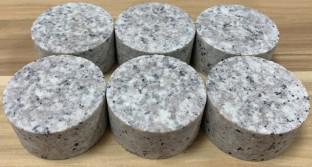Natural Resources Research ( IF 5.4 ) Pub Date : 2022-06-29 , DOI: 10.1007/s11053-022-10091-2 Chengzheng Cai , Keda Ren , Zhixiang Tao , Yan Xing , Feng Gao , Zengxin Zou , Yinrong Feng

|
To reveal the damage characteristics of high-temperature granite caused by liquid nitrogen (LN) treatment, ultrasonic, Brazilian splitting, and acoustic emission (AE) tests were performed on high-temperature granite before and after LN treatment. Changes in ultrasonic velocity, tensile strength, energy evolution laws, and AE parameters induced by heating, LN cooling, and LN-induced cryogenic conditions were evaluated and compared. The results showed that LN cooling can create additional cryogenic damage to high-temperature granite, thereby increasing the damage degree. With heating temperature rising, the preliminary damage of high-temperature granite increased significantly. For heating temperatures of < 300 °C, the damage degree induced by LN cooling increased with increase in heating temperature. However, with the preliminary damage of high-temperature granite increasing, the damage induced by LN cooling was weakened. For example, when temperature was > 300 °C, the decreasing amplitudes of ultrasonic velocity, tensile strength, and ultimate elastic and absorbed energies induced by LN cooling decreased with increased heating temperature and were much lower than those induced by heating. Especially, when heating temperature was > 300 °C, the deformation resistance and total shrinkage of high-temperature granite were greatly improved by LN-induced cryogenic conditions. In this case, the tensile strength, ultimate absorbed and elastic energies, and the proportion of elastic energy of LN-frozen samples were larger than the heated samples. This study provides theoretical guidance for hot dry rock fracturing with LN.
中文翻译:

高温花岗岩液氮处理损伤特性试验研究
为了揭示液氮(LN)处理对高温花岗岩的损伤特征,对液氮处理前后的高温花岗岩进行了超声波、巴西劈裂和声发射(AE)试验。评估和比较了由加热、LN 冷却和 LN 诱导的低温条件引起的超声速度、拉伸强度、能量演化规律和 AE 参数的变化。结果表明,LN冷却可以对高温花岗岩造成额外的低温损伤,从而增加损伤程度。随着加热温度的升高,高温花岗岩的初步破坏显着增加。对于<300 ℃的加热温度,LN冷却引起的损伤程度随着加热温度的升高而增加。然而,随着高温花岗岩初步损伤的增加,LN冷却引起的损伤减弱。例如,当温度 > 300 °C 时,LN 冷却引起的超声速度、拉伸强度、极限弹性和吸收能的减小幅度随着加热温度的升高而减小,并且远低于加热引起的幅度。特别是当加热温度> 300 ℃时,高温花岗岩的变形抗力和总收缩率在LN诱导的低温条件下大大提高。在这种情况下,LN冷冻样品的抗拉强度、极限吸收能和弹性能以及弹性能的比例均大于加热样品。该研究为干热岩液氮压裂提供了理论指导。LN冷却引起的损伤减弱。例如,当温度 > 300 °C 时,LN 冷却引起的超声速度、拉伸强度、极限弹性和吸收能的减小幅度随着加热温度的升高而减小,并且远低于加热引起的幅度。特别是当加热温度> 300 ℃时,高温花岗岩的变形抗力和总收缩率在LN诱导的低温条件下大大提高。在这种情况下,LN冷冻样品的抗拉强度、极限吸收能和弹性能以及弹性能的比例均大于加热样品。该研究为干热岩液氮压裂提供了理论指导。LN冷却引起的损伤减弱。例如,当温度 > 300 °C 时,LN 冷却引起的超声速度、拉伸强度、极限弹性和吸收能的减小幅度随着加热温度的升高而减小,并且远低于加热引起的幅度。特别是当加热温度> 300 ℃时,高温花岗岩的变形抗力和总收缩率在LN诱导的低温条件下大大提高。在这种情况下,LN冷冻样品的抗拉强度、极限吸收能和弹性能以及弹性能的比例均大于加热样品。该研究为干热岩液氮压裂提供了理论指导。LN冷却引起的超声速度、拉伸强度、极限弹性和吸收能量的减小幅度随着加热温度的升高而减小,并且远低于加热引起的幅度。特别是当加热温度> 300 ℃时,高温花岗岩的变形抗力和总收缩率在LN诱导的低温条件下大大提高。在这种情况下,LN冷冻样品的抗拉强度、极限吸收能和弹性能以及弹性能的比例均大于加热样品。该研究为干热岩液氮压裂提供了理论指导。LN冷却引起的超声速度、拉伸强度、极限弹性和吸收能量的减小幅度随着加热温度的升高而减小,并且远低于加热引起的幅度。特别是当加热温度> 300 ℃时,高温花岗岩的变形抗力和总收缩率在LN诱导的低温条件下大大提高。在这种情况下,LN冷冻样品的抗拉强度、极限吸收能和弹性能以及弹性能的比例均大于加热样品。该研究为干热岩液氮压裂提供了理论指导。LN冷却引起的极限弹性能和吸收能随着加热温度的升高而降低,远低于加热引起的。特别是当加热温度> 300 ℃时,高温花岗岩的变形抗力和总收缩率在LN诱导的低温条件下大大提高。在这种情况下,LN冷冻样品的抗拉强度、极限吸收能和弹性能以及弹性能的比例均大于加热样品。该研究为干热岩液氮压裂提供了理论指导。LN冷却引起的极限弹性能和吸收能随着加热温度的升高而降低,远低于加热引起的。特别是当加热温度> 300 ℃时,高温花岗岩的变形抗力和总收缩率在LN诱导的低温条件下大大提高。在这种情况下,LN冷冻样品的抗拉强度、极限吸收能和弹性能以及弹性能的比例均大于加热样品。该研究为干热岩液氮压裂提供了理论指导。极限吸收能和弹性能, LN 冷冻样品的弹性能比例大于加热样品。该研究为干热岩液氮压裂提供了理论指导。极限吸收能和弹性能, LN 冷冻样品的弹性能比例大于加热样品。该研究为干热岩液氮压裂提供了理论指导。


























 京公网安备 11010802027423号
京公网安备 11010802027423号